How-To Geek
How to loop a powerpoint presentation.

Your changes have been saved
Email is sent
Email has already been sent
You’ve reached your account maximum for followed topics.

Quick Links
Set up your slideshow to be looped, apply automatic slide transitions.
Slideshows are sometimes used to display images at events, such as weddings or trade shows. Whatever the occasion might be, you’ll want to loop your PowerPoint presentation so your guests aren’t staring at a blank screen. Here’s how it’s done.
First, open your PowerPoint presentation in which you would like to loop. Once open, navigate to the “Set Up” group of the “Slide Show” tab and then select the “Set Up Slide Show” button.
The “Set Up Show” window will appear. In the “Show options” group, check the box next to “Loop Continuously until Esc.” Once selected, click “OK” in the bottom-right corner of the window.
Now, when you play your slideshow, it will end only when you press the “Esc” key instead of when you've finished the last slide.
Related: How to Make YouTube Videos Loop Continuously
One caveat: With the way we currently have it set up, the slideshow will proceed only when someone clicks the mouse button. That’s fine if there will be a speaker present at all times. Otherwise, you’ll need to set up automatic slide transitions.
Head back to the “Set Up Show” window by selecting “Set Up Slide Show” in the “Set Up” group of the “Slide Show” tab.
There are a couple of options you need to select, but one important note is that you must first select “Using Timings, If Present” under the “Advance Slides” group.
The next option we select will lock a few things in place (which is why you need to select “Using Timings, If Present” first).
Under the “Show Type” group, select “Browsed at a Kiosk (Full Screen)." The “Loop Continuously until Esc” option will be enabled automatically if you haven’t already turned it on, and the option you’ve selected under “Advance Slides” will remain unchanged.
Select “OK” when ready to proceed.
Without the “Browsed at a Kiosk” option enabled, the automatic slide progressions would be disabled if someone were to press the Back key. With it enabled, the Forward and Back keys are locked, allowing the slideshow to automatically progress unattended without fear of someone breaking it.
Now it’s time to set the timings of the slides. Head over to the “Transitions” tab. In the “Timing” group, check the box next to “After” and set the timing at which you’d like each slide to progress. Note that it doesn’t matter if the box next to “On Mouse Click” is checked or not---it won’t work.
After that, select the “Apply to All” option in the same group.
Now, when you play your slideshow, it will continuously loop without interruption. To exit the slideshow, press the “Esc” button.
- Microsoft Office

How to Make a PowerPoint Loop? (Step-By-Step Guide)
Have you ever come across a presentation that just keeps on going? It’s mesmerizing, isn’t it? Imagine being able to create a looping presentation within PowerPoint that is sure to captivate your audience.

Well, you can! In this article, we’re going to walk you through the steps of creating your own looping presentation, from understanding what a looping presentation is to setting the slide show to loop.
We’ll also provide some helpful tips and troubleshooting advice so you can make a successful loop and achieve the presentation of your dreams.
Let’s get started!
Table of Contents
Short Answer
To make a PowerPoint loop, start by creating the presentation you want to loop.
Then go to the “Transitions” tab, and check the box next to “On Mouse Click” and select “Loop Until Stopped”.
Finally, save your presentation and you should be able to play it in a continuous loop.
What is a Looping Presentation?
A looping presentation in PowerPoint is a great way to capture and keep viewers engaged and entertained.
This type of presentation allows you to create a continuous cycle of animations that play one after the other.
Its an effective way to deliver information in an efficient and engaging way.
Looping presentations can be used for a variety of purposes, such as to educate, explain processes, or just to entertain.
For example, if youre creating a presentation about a process, like how to make a cup of tea, you can use looping to walk viewers through each step.
When viewers reach the end of the cycle, they can simply start from the beginning and watch the entire process again.
In addition, looping presentations can be used to create a sense of atmosphere.
For example, if youre creating a presentation about a beach, you can use looping to show a continuous cycle of images of the beach.
This can help create an immersive experience for viewers, and help keep their attention on your presentation.
Finally, looping presentations can also be used to create a visual aid while someone is speaking.
For example, if youre giving a presentation about the history of a certain city, you can use looping to show a continuous cycle of images related to that citys history.
This will help viewers understand the information more clearly and help reinforce your message.
What Do You Need to Make a PowerPoint Loop?
To make a PowerPoint loop, you will need a few basic tools.
First, you will need a computer running Microsoft PowerPoint.
This will allow you to access the Animation Pane, which is essential for creating the looping presentation.
Additionally, you may want to have access to a few other tools, such as an image editing program or a video editing program, depending on what type of presentation you are creating.
Finally, you will need to have a basic understanding of how to use PowerPoint and how to use the Animation Pane.
Once you have all the necessary tools, you can begin creating your looping presentation.
To get started, you will need to open a new PowerPoint presentation and create a few slides with your desired content.
You can add images, text, and videos to your slides to make them more engaging.
Once you have all your content in place, you can begin creating the looping animation.
How to Use the Animation Pane
Using the Animation Pane to create a looping PowerPoint presentation is a great way to ensure that viewers stay engaged and entertained.
To make a PowerPoint loop, the first step is to access the Animation Pane in the ribbon.
This can be done by clicking the Animation tab and then selecting the Animation Pane option.
Once the Animation Pane is open, you can begin to create a sequence of animations that will loop through one after the other.
To do this, first select the object that you want to animate.
Then, click on the Add Animation drop-down menu at the top of the Animation Pane to select the animation that you want to apply to the object.
You can also preview the animation by clicking on the Play button in the Animation Pane.
To add additional animations to the sequence, select another object and repeat the steps.
When you have created the sequence of animations that you want to loop, you can adjust the timing of the animations by selecting the animation in the Animation Pane and then clicking on the Timing tab.
Here, you can set the delay and duration of the animation, and also choose whether you want it to start After Previous or With Previous.
Once you are happy with the sequence of animations, you can set the presentation to loop in the Slide Show settings.
To do this, go to the Slide Show tab and select the Set Up Slide Show option.
Then, check the box next to the Loop Until Stopped option.
This will ensure that your looping presentation will continue to play until the viewer manually stops it.
By following these simple steps, you can easily create an engaging, looping PowerPoint presentation that will keep viewers entertained.
Creating a Sequence of Animations
Creating a looping presentation in PowerPoint is a great way to keep your audience engaged and entertained.
To make a PowerPoint loop, you’ll need to use the Animation Pane to create a sequence of animations that will play one after the other.
In the Animation Pane, you can add individual animations to slides, or groups of animations that will play in succession.
Animations can be set to play when a slide is first displayed, or after a certain period of time has elapsed.
You can also set the duration of each animation, and the order in which they will play.
Adding animations to your slides gives you more control over the presentation, and makes it easier to create a loop.
For example, if you have a slide that has several different elements, you can add multiple animations to each element, and then set the animations to play in succession.
This will create a more dynamic presentation that will keep the audience engaged.
Additionally, you can use animations to control the speed and pacing of the presentation, as well as adding visual effects to the slides.
Once you have added the animations to your slides, you’ll need to set the presentation to loop in the Slide Show settings.
In the Slide Show tab, you can choose to loop the presentation continuously, or after a certain number of slides.
You can also set the presentation to restart at the beginning after it reaches the end.
With this setting enabled, your presentation will loop continuously until you manually stop it.
By following these simple steps, you can easily create an engaging, looping PowerPoint presentation.
With the Animation Pane, you can add multiple animations to each slide, and set the presentation to loop continuously.
This will allow you to create an interesting and engaging presentation that will keep your audience entertained.
Setting the Slide Show to Loop
Once you have created your sequence of animations within the Animation Pane, you will need to set the presentation to loop in the Slide Show settings.
To do this, first go to the Slide Show tab and click on the Set Up Slide Show button.
This will bring up a window with several options.
At the bottom of the window, you will see an option to Loop continuously until Esc.
Click this box to enable the looping feature.
Once you have enabled this feature, your presentation will loop continuously until you press the Escape key.
You can also set the looping feature to a specific number of times, if you would like the presentation to only play a certain number of times before stopping.
To do this, click the Loop until Stopped option in the Set Up Slide Show window.
You can then enter the number of times you would like the presentation to loop in the Loop for box.
Once you have enabled the looping feature, you can click the OK button in the Set Up Slide Show window to save your settings.
Your presentation is now set to loop continuously until you press the Escape key.
This will ensure that your audience stays engaged and entertained for the duration of your presentation.
Tips for Creating a Successful Loop
Creating a successful looping PowerPoint presentation requires planning and attention to detail. Its important to consider the flow of the presentation, as well as the timing of the animations. Here are a few tips to help you create an engaging, looping PowerPoint presentation:
1. Start with a strong introduction. Make sure to grab your audiences attention from the get-go. This could be a catchy headline, an interesting fact, or a thought-provoking quote.
2. Make sure your animations are timed correctly. If the animations are too fast or too slow, the presentation wont be as effective.
3. Limit the number of animations. Too many animations can make the presentation feel cluttered and overwhelming. Stick to the most important elements and use subtle animations to keep the presentation interesting .
4. Make sure the animations are relevant to the content. Animations should enhance the content, not distract from it.
5. Use transitions to create a seamless loop. Transitions can help create a smooth transition between slides and make the presentation feel more cohesive.
6. Test the presentation before sharing it. Make sure to view the presentation in Slide Show mode and test the looping feature to ensure that everything works as expected.
Following these tips can help you create an engaging, looping PowerPoint presentation that will keep your audience engaged and entertained.
Troubleshooting Common Issues
When it comes to troubleshooting common issues with a PowerPoint loop, there are a few tips to keep in mind.
First, make sure that the animation sequence is set up correctly.
Make sure that each animation is set to play after the previous one and that the last animation is set to loop back to the beginning.
Additionally, always double check the Slide Show settings to make sure the presentation is set to loop.
If the loop isn’t playing correctly, or if the presentation stops after the last animation, try resetting the slide show.
To do this, simply press the Slide Show button in the ribbon and then press the Escape key.
This will reset the show and should allow the loop to play correctly.
If animations aren’t playing when the slide show starts, check the timing settings.
Make sure that each animation is set to start at the beginning of the slide as this is necessary for the loop to work correctly.
Finally, if the loop isn’t working as expected, try reloading the presentation.
This usually fixes any issues with the animation sequence or slide show settings.
Final Thoughts
Creating a looping presentation in PowerPoint is a great way to keep viewers engaged and entertained.
With the steps outlined above, you can easily make a looping PowerPoint presentation by using the Animation Pane to create a sequence of animations and setting the Slide Show to loop.
Keep in mind the tips for creating a successful loop and troubleshoot any common issues you may encounter.
Now you’re all set to make an engaging and eye-catching looping PowerPoint presentation.
Go ahead and give it a try!
James Wilson
James Wilson has extensive knowledge in the information technology industry.His second love, besides dealing with computers, is smart home technology. He is continually updating information to better comprehend this problem and has a deep understanding of the apartment’s support system.
Recent Posts
What Is Fiverr Social Media Kit? Unlocking Your Online Presence
Fiverr's Social Media Kit is a suite of tools designed to help freelancers and small business owners promote their services on various social media platforms. The kit includes templates, graphics,...
Is Fiverr A Legit Website? Separating Fact From Fiction
Fiverr is a legitimate freelance services marketplace that connects buyers with sellers offering various skills and services. The platform has been in operation since 2010 and has gained popularity...
How to Loop a PowerPoint Presentation?
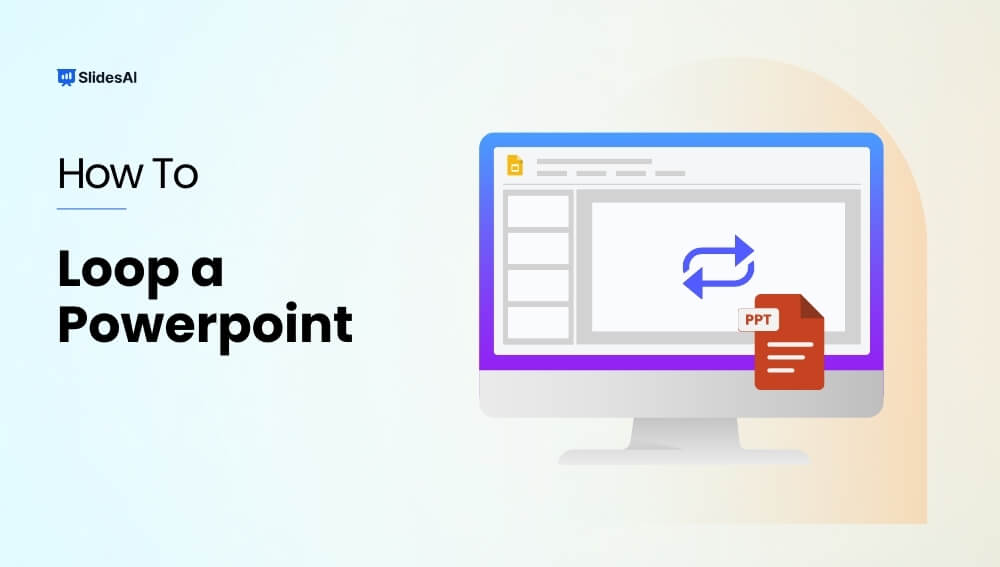
Table of Contents
PowerPoint presentations are a go-to for clear and informative content delivery. But what if you want your presentation to run on repeat, like at a kiosk or digital sign? The good news is, that PowerPoint has a built-in feature to loop your slideshow, ensuring your message stays on display without interruption.
This blog post will guide you through the simple steps to set your presentation on a loop, keeping your audience engaged and informed around the clock.
What is PowerPoint Looping?
Normally, in a PowerPoint presentation, you have to manually move from one slide to the next by pressing keys on the keyboard or clicking buttons on a mouse or presentation remote.
However, when you enable looping in PowerPoint, the presentation progresses automatically from one slide to the next without requiring manual input. This eliminates the need for the presenter to interact with the computer or mouse during the presentation.
With PowerPoint looping, you can also set each slide to display automatically for a specified duration, determined by you. Once the preset time elapses, the next slide seamlessly appears. Additionally, upon reaching the final slide, the slideshow automatically starts over from the beginning.
Why Do You Need to Loop Your Slideshow in PowerPoint?
There are several reasons why you might want to loop your slideshow in PowerPoint:
- Unattended Presentations: Looping is ideal for situations where the presentation runs without a presenter. This could be at a kiosk, trade show booth, or in a waiting room. Looping ensures the information is continuously displayed for viewers to come and go as they please.
- Automated Playback: Looping allows for a hands-off presentation experience. Once started, the presentation progresses automatically, freeing you up to greet attendees or answer questions.
- Self-Paced Learning: Looping can be useful for self-paced learning environments. Viewers can revisit slides or take breaks without needing someone to control the flow.
- Continuous Engagement: Looping keeps the audience engaged with a constant stream of information. This can be beneficial for displaying menus, directions, or other ongoing updates.
Create presentation slides with AI in Seconds in Google Slides
10M+ Installs
Works with Google Slides
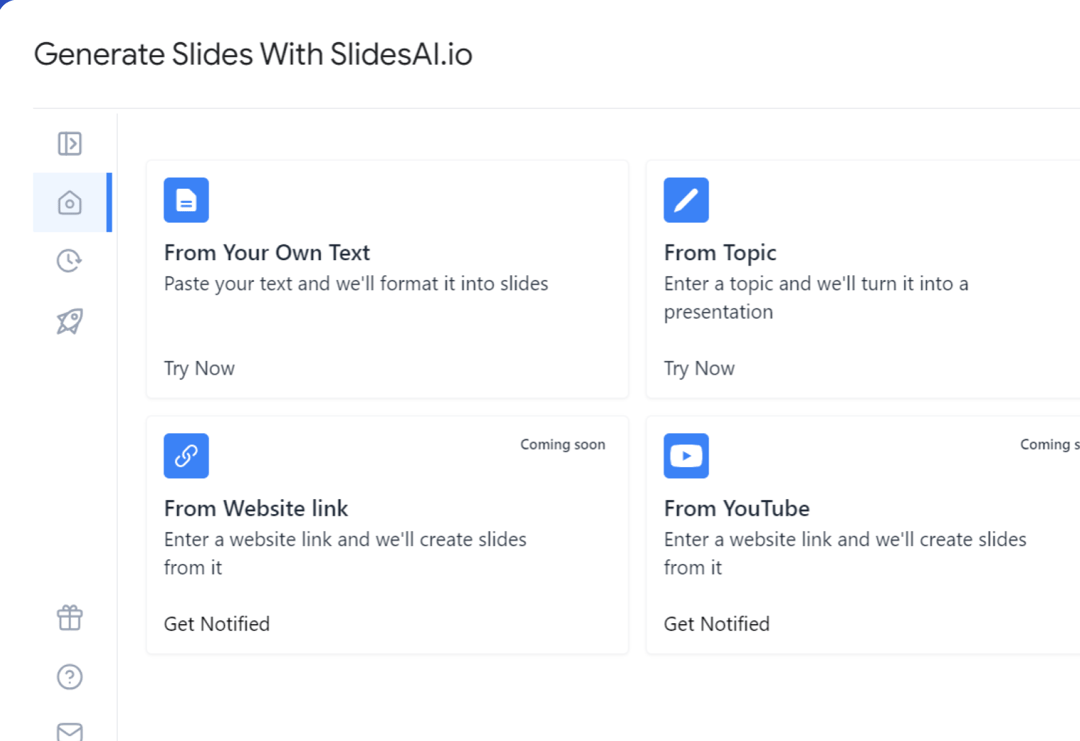
How to Make a PowerPoint Presentation loop?
Ready to loop your presentation? Here’s how it’s done:
Step 1: Open your PowerPoint and head over to the “Slide Show” tab.
Step 2: Click the button that says “Set Up Slide Show.” A new window will pop up.
Step 3: Under “Show options,” find the magic checkbox that says “Loop continuously until ‘Esc’.” Check that box to make your presentation run on repeat.
Step 4: Want to control how long each slide shows? Look for the option “Automatically advance slides” and check it. Then, use the up and down arrows to set the display time for each slide.
Step 5: Once you’re happy with the settings, click “OK” to save them.
Step 6: Time to loop! Go back to the “Slide Show” tab and click “From Beginning” (or “From Start”). Your presentation will start playing and keep going until you press the “Esc” key.
How To Loop a PowerPoint SlideShow from Selected Slides?
PowerPoint lets you loop a customized selection of slides, creating engaging presentations that run unattended. This eliminates the need for manual slide changes while maintaining audience interest. Here’s how to loop specific slides:
Step 1: Select Slides: In the Slide Sorter view, hold “Shift” and click the first and last slides you want to loop.
Step 2: Enable Looping: Go to the “Slide Show” tab and click “Set Up Show.” Check the box for “Loop continuously until ‘Esc'” and choose “Show slides” from the dropdown menu. Select “From” and enter the slide number where your loop should begin.
Step 3: Create Custom Show (Optional): For easier access, name your looped sequence as a “Custom Show” within the “Set Up Show” dialog.
Step 4: Start Looping: Navigate back to the “Slide Show” tab and choose “Custom Slide Show” to launch your looped presentation.
Closing Thoughts
Looping your PowerPoint presentation is a simple yet powerful technique that unlocks a variety of use cases. By following these steps, you can ensure your message runs continuously, keeping your audience informed and engaged, whether it’s at a kiosk, trade show booth, waiting room, or any other scenario that demands unattended playback.
- No design skills required
- 3 presentations/month free
- Don’t need to learn a new software
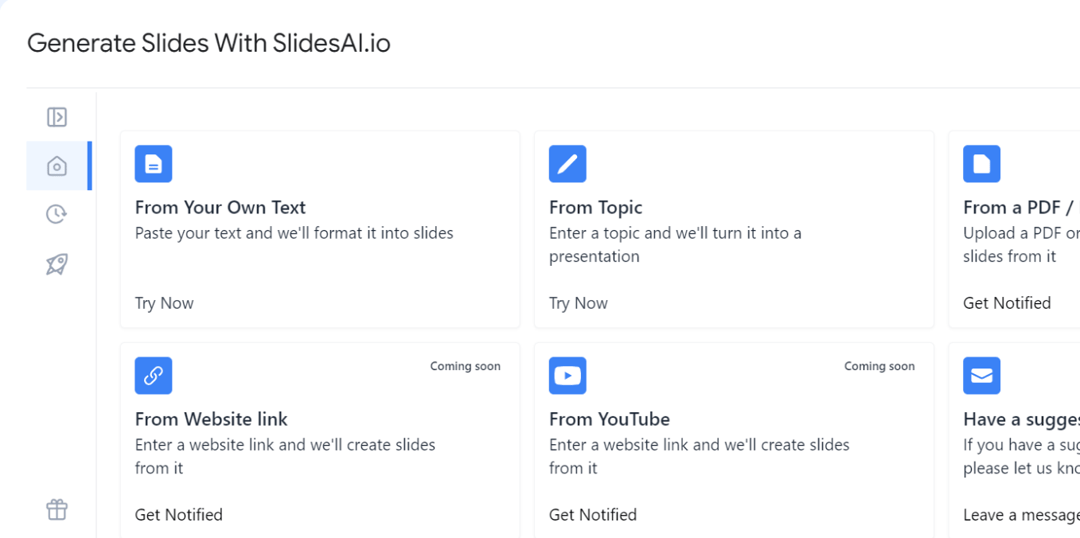
Frequently Asked Questions
My presentation has animations and transitions. will they loop as well.
Absolutely! When you loop your presentation, animations and transitions will also repeat continuously, regardless of the looping method you choose.
Does looping affect animation timing?
There’s a possibility. Looping might affect how your animations play out, especially if they have specific timings set. To avoid any hiccups, be sure to thoroughly test your looped presentation. This will ensure your animations sync smoothly with the slide transitions.
Can I loop specific slides in my PowerPoint presentation?
Yes! PowerPoint gives you the flexibility to loop a selected group of slides, creating engaging presentations that run unattended.
How do I stop or pause a looped slideshow in PowerPoint?
Need a break? Simply press the “Esc” key on your keyboard to interrupt the looped slideshow at any time.
Can I customize the duration of each slide in a looped PowerPoint presentation?
Yes, you can! PowerPoint allows you to adjust the slide transition settings for each slide. This lets you control how long each slide displays, creating a tailored and dynamic looping experience.
Related Posts
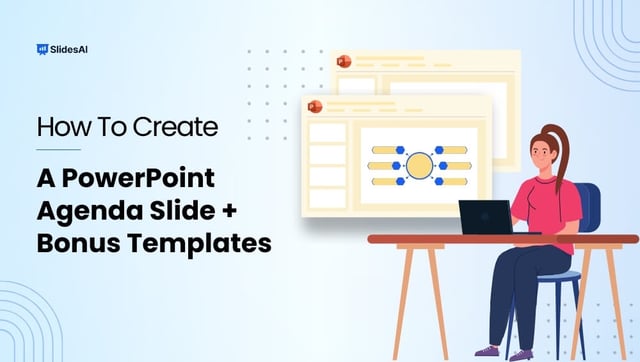
How to Create Agenda Slide in Powerpoint?
Ever feel like your PowerPoint presentations could benefit from a strong start? Using an agenda slide at the beginning can be a helpful way to take charge of your presentation from the get-go.

How to End a PowerPoint Presentation?
Picture this: The lights dim, the room hushes, and your presentation is in full swing. But as you near the end, there’s a sense of anticipation, not boredom. Your audience leans in, hungry for that final spark to ignite their minds. That’s the power of a captivating conclusion. The secret sauce that leaves your audience […]
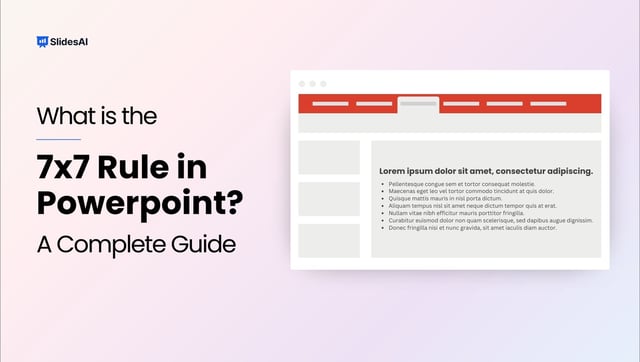
7X7 Rule in PPT (PowerPoint Presentation)
Captivate your audience with impactful presentations using the 7×7 rule. This design principle encourages a clear and focused approach by limiting slides to a mere 7 lines of text, each containing a maximum of 7 words. By adhering to this format, you can craft presentations that are not only easy to digest but also leave a lasting impression on your viewers. Let’s jump into the article and find out how it works.

Save Time and Effortlessly Create Presentations with SlidesAI

How to Loop a Powerpoint Office 365 Slideshow
For typical Powerpoint presentations that you just show to one person, you likely aren’t concerned with what happens when the slideshow is over.
But some situations call for a slideshow to continue playing for an extended period of time.
This means that you will need to learn how to loop a Powerpoint Office 365 presentation so that it plays continuously.
How to Do a Powerpoint for Office 365 Slideshow Loop
- Open the presentation.
- Select the Slide Show tab.
- Choose Set Up Slide Show .
- Check the Loop continuously until Esc box.
- Click the top slide, hold down Shift , then click the last slide.
- Choose the Transitions tab.
- Uncheck On Mouse Click , check After , then set a duration for each slide.
Our guide continues below with more information on how to loop a Powerpoint Office 365 presentation, including pictures of these steps.
Sometimes you will create a presentation in Powerpoint that is going to be shown someplace where it will be unattended.
This could be at a trade show, in an office, or anywhere else where there is a TV or computer screen.
Constantly having to restart that slideshow yourself is often impractical, and would be tedious even if you were physically able to attend to it.
Fortunately, it’s possible to create a slideshow loop in Powerpoint so that the presentation will play continuously once it has concluded.
Our guide below will show you how to create a Powerpoint slideshow loop in Microsoft Powerpoint for Office 365.
Documents with pictures often need some adjustments before they look their best. You can find out more with our how to flip an image in Word article .
How to Make a Powerpoint Slideshow Loop (Guide with Pictures)
The steps in this article were performed in the Microsoft Powerpoint for Office 365 version of the application, but will work in most other versions of the application as well.
Note that the presentation can loop on its own, but you may need to adjust any screensaver or hibernation settings on your computer so that the screen will remain on.
Step 1: Open your slideshow in Powerpoint.
Step 2: click the slide show tab at the top of the window..
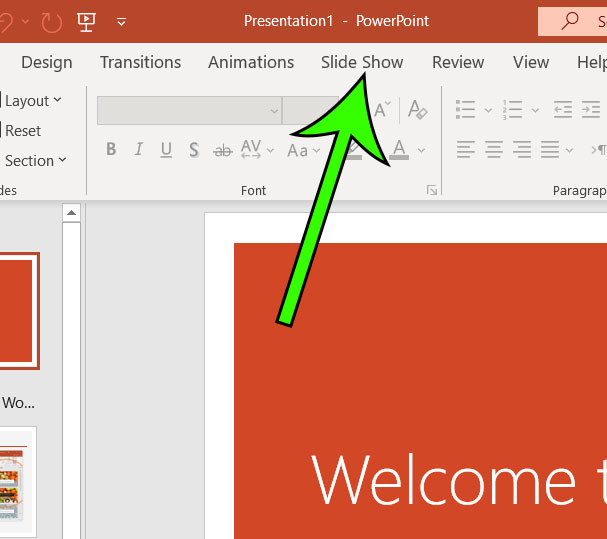
Step 3: Click the Set Up Slide Show button.
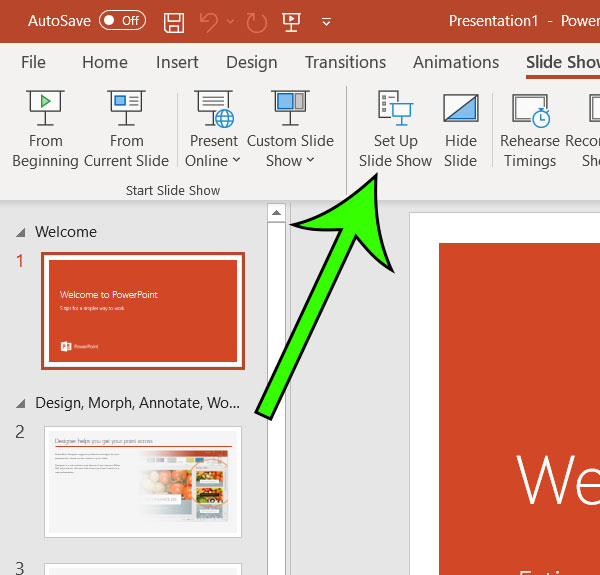
Step 4: Check the box to the left of Loop continuously until Esc , then click OK .
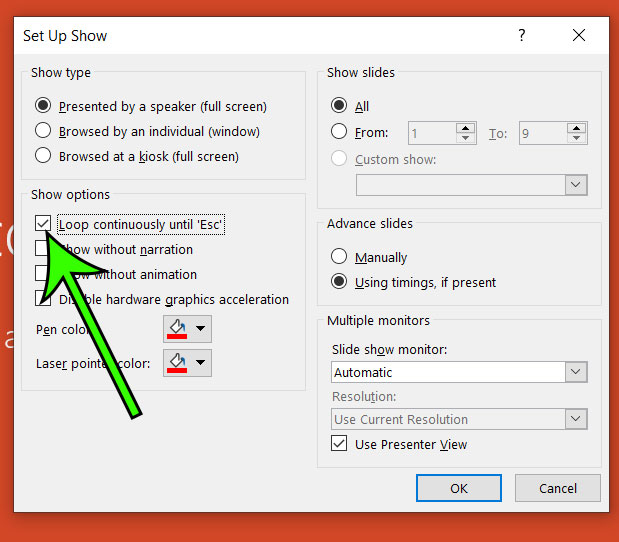
Step 5: Click your first slide in the column at the left side of the window, then hold down the Shift key, scroll down and click the last slide.
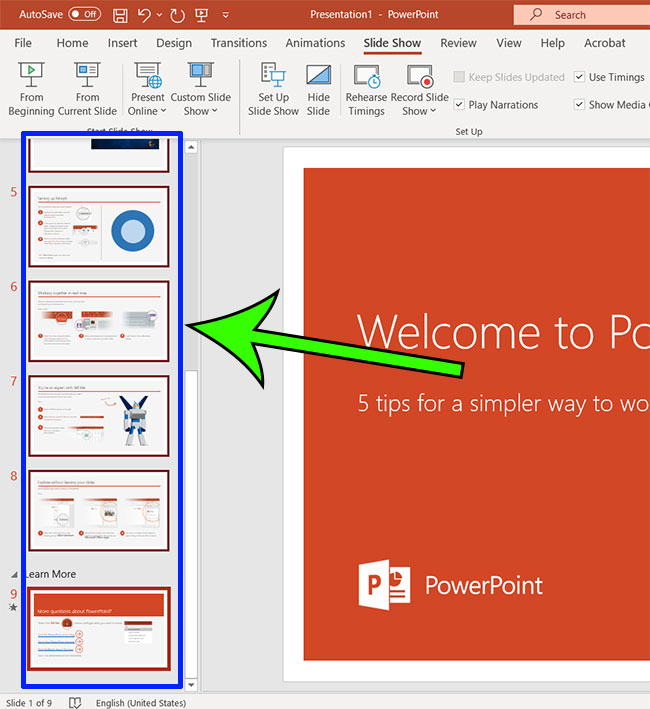
Step 6: Select the Transitions tab at the top of the window.
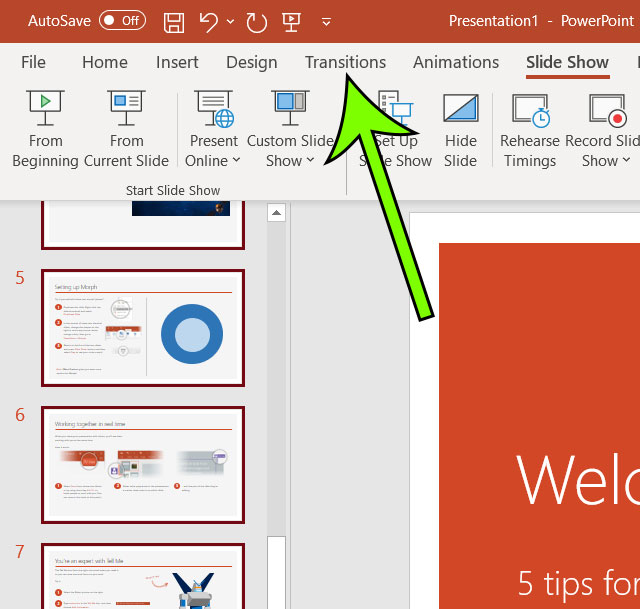
Step 7: Click the box to the left of On Mouse Click to remove the check mark, check the box to the left of After , then choose the amount of time to display each slide.
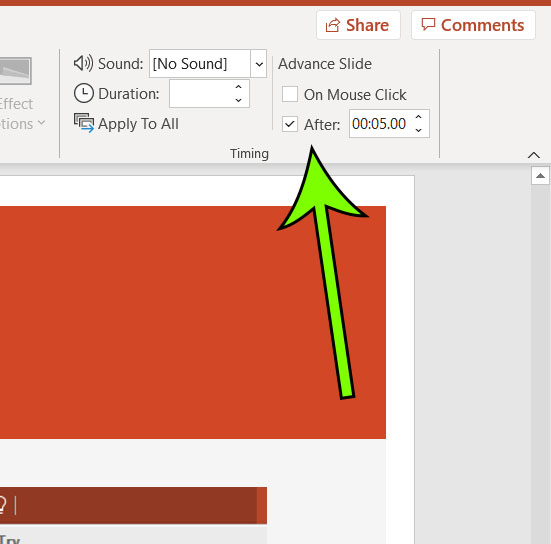
I have set my slideshow to display each slide for 5 seconds in the image above.
You can start your slideshow at any time by pressing the F5 key on your keyboard.
You can stop the slideshow by pressing the Esc key on your keyboard.
You should now know how to loop a Powerpoint Office 365 presentation so that it continuously plays on repeat until you press the Esc key on your keyboard to terminate it.
Find out how to change your slide size in Powerpoint if you need a different orientation or slide dimensions for your presentation.

Matt Jacobs has been working as an IT consultant for small businesses since receiving his Master’s degree in 2003. While he still does some consulting work, his primary focus now is on creating technology support content for SupportYourTech.com.
His work can be found on many websites and focuses on topics such as Microsoft Office, Apple devices, Android devices, Photoshop, and more.
Share this:
- Click to share on Twitter (Opens in new window)
- Click to share on Facebook (Opens in new window)
Related Posts
- How to Rotate a Powerpoint Slide Presentation
- How to Mirror Image in PPT Files (An Easy 6 Step Guide)
- How to Change Slide Size in Powerpoint 2016
- How to Do a Powerpoint Google Slides Presentation Conversion
- How to Add a Hyperlink on Google Slides
- Can You Print a Google Slide?
- How to Make Google Slides Vertical (5 Quick Steps)
- How to Save a Picture to Your Computer from Powerpoint for Office 365
- How to Stop Hiding a Slide in Google Slides
- How to Skip a Slide in Google Slides
- How to Make Columns in Word Office 365
- How to Make Text Vertical in Google Docs
- How to Set Google Docs Background Image
- Can You Download Google Slides Files?
- How to Save a Single Slide as a Picture in Google Slides
- How to Change Page Color in Word for Office 365 (An Easy 4 Step Guide)
- How to Get the Excel 365 Developer Tab in Microsoft Excel for Office Today
- How to Not Print Comments in Word (An Easy 5 Step Guide)
- How to Double Space in Word Office 365
- How to Bring an Image to the Front in Google Slides
Get Our Free Newsletter
How-to guides and tech deals
You may opt out at any time. Read our Privacy Policy
How to: Effortlessly Create PowerPoint Looping Presentations
Looping presentations in PowerPoint can be a game-changer for those needing to display information continuously. It’s a straightforward process: Set up your slides, head to the ‘Slide Show’ tab, click on ‘Set Up Slide Show’, tick the ‘Loop continuously until ‘Esc” box, and voila – your presentation is set to loop.
After completing this action, your PowerPoint presentation will automatically replay from the beginning once it reaches the end. This is particularly useful for presentations displayed at kiosks, trade shows, or in waiting areas, ensuring your audience doesn’t miss any content.
Introduction
Ever been to a trade show and noticed how some booths have screens with presentations that seem to run endlessly? That’s the magic of looping presentations, a feature that’s built into PowerPoint but not always used to its fullest potential.
Having a presentation loop can serve multiple purposes. For those in marketing, it means your message is continually being broadcast without the need for manual intervention. For educators, it could mean students have more time to absorb information. And for those in the corporate world, it ensures that important data is consistently on display for stakeholders and team members to see.
Looping presentations are not only efficient but also incredibly simple to set up in PowerPoint. Knowing how to do this is a great skill to have in your back pocket. Whether you’re prepping for an exhibition, setting up a self-running informational display, or just want to make sure your audience can see your presentation in its entirety, no matter when they walk in the room – this article is for you.
PowerPoint Looping Presentations Tutorial
Before diving into the steps, it’s important to understand what we’re aiming to achieve. By the end of this tutorial, your PowerPoint presentation will be capable of running on its own, looping endlessly until manually stopped. It’s an excellent way to keep an audience engaged with your content, even if you’re not actively presenting.
Step 1: Open your PowerPoint presentation
Open the PowerPoint presentation you wish to loop.
When you have your presentation open, you’ll want to ensure that all your slides are in the correct order and that any timings, animations, or transitions are set up as you want them. This is crucial because once the presentation starts looping, these aspects will play over and over again.
Step 2: Click on the ‘Slide Show’ tab
Navigate to the ‘Slide Show’ tab located on the ribbon at the top of PowerPoint.
The ‘Slide Show’ tab is where you’ll find all the settings related to the presentation’s display. It’s your control center for how the presentation will run.
Step 3: Select ‘Set Up Slide Show’
Click on the ‘Set Up Slide Show’ button within the ‘Slide Show’ tab.
This action opens a new window with various options for running your presentation. It’s like the backstage area before a performance, where you make all the necessary tweaks.
Step 4: Choose ‘Loop continuously until ‘Esc”
In the ‘Set Up Show’ window, check the box that says ‘Loop continuously until ‘Esc”.
This is the setting that transforms your presentation from a one-time run-through to an endlessly looping display. It’s the crucial step in ensuring your content gets maximum exposure.
Step 5: Save your settings
Click ‘OK’ to save your settings and close the ‘Set Up Show’ window.
Once you’ve clicked ‘OK’, your presentation is all set to loop. You can start the slideshow to test it out and see your handiwork in action.
Continuous Display
By looping your PowerPoint presentation, you ensure that no matter when someone walks by or starts watching, they’ll be able to see the whole thing. It’s ideal for environments where you have a rotating audience, like at conferences or informational booths.
Time-Saving
Once set up, you don’t need to stick around to restart the presentation. It loops automatically, freeing you up to do other things – like interacting with your audience or managing other aspects of your event or meeting.
Professionalism
A self-running, looping presentation can make a statement about your professionalism. It shows that you’ve put thought into how your information is presented and that you’re adept at using technology to enhance your message.
Can be Ignored
When people know a presentation is looping, they might not give it their full attention, thinking they’ll catch the next round. This could mean your message isn’t hitting home as strongly as you’d like.
Technical Issues
Technology isn’t foolproof. If your PowerPoint or the device it’s running on experiences issues, your looping presentation could grind to a halt – often at the most inopportune times.
Repetitiveness
For those who are around for a while, a looping presentation can become like that one song on the radio that’s played too often – annoying. Finding the balance between informative and overkill is key.
Additional Information
PowerPoint’s looping feature might seem simple, but it can be incredibly powerful when used correctly. Think about the last time you walked past a looping video or presentation – it probably caught your eye, at least for a moment. That’s the draw of a looping display; it’s always there, always ready to catch the attention of someone new.
One tip is to ensure your presentation is designed with looping in mind. This means avoiding content that could become quickly dated or using language that implies the presentation is a one-time event. Instead, use evergreen content that will be relevant no matter how many times it’s viewed.
Another consideration is the length of your presentation. If it’s too long, viewers might not stick around for the whole loop, missing out on key information. If it’s too short, it could become annoyingly repetitive. Striking the right balance is essential.
When setting up your looping presentation, think about the context in which it will be viewed. Is it in a noisy trade show hall? Consider adding subtitles or visual cues that can be understood without sound. Is it in a quiet waiting area? Maybe a softer, less attention-grabbing approach is needed.
Remember, the goal of a PowerPoint looping presentation is to inform and engage, not to overwhelm or annoy. Keep your audience’s experience in mind, and you’ll be sure to create a looping presentation that adds value and captures interest.
- Open your PowerPoint presentation.
- Click on the ‘Slide Show’ tab.
- Select ‘Set Up Slide Show’.
- Choose ‘Loop continuously until ‘Esc”.
- Save your settings.
Frequently Asked Questions
What if my presentation has videos.
If your presentation contains videos, make sure they’re set to play automatically and check the box ‘Rewind after playing’ to ensure they loop with the rest of the slides.
Can I loop just one section of my presentation?
Yes, you can loop specific sections by using custom shows within PowerPoint. It’s a bit more complex but entirely possible.
Will looping work if I have transition timings set up?
Absolutely. Your slides will transition according to the timings you’ve set, looping back to the beginning when they reach the end.
How do I stop a looping presentation?
Simply press the ‘Esc’ key, and the presentation will stop looping and exit the slideshow view.
Can I loop a presentation on a Mac?
Yes, the steps are the same for PowerPoint on a Mac as they are for Windows.
Mastering PowerPoint looping presentations is like unlocking a new level in your presentation skills. It’s not just about making your slides look pretty; it’s about ensuring your message is always out there, always engaging, and always ready to inform. Whether you’re in the boardroom, at a booth, or in an educational setting, a well-crafted looping PowerPoint can make all the difference.
So go ahead, give it a try – your audience will thank you for it. And remember, the best presentations are those that not only deliver information but do so in a way that’s seamless and ever-present, just like the perfect loop.

Matthew Burleigh has been writing tech tutorials since 2008. His writing has appeared on dozens of different websites and been read over 50 million times.
After receiving his Bachelor’s and Master’s degrees in Computer Science he spent several years working in IT management for small businesses. However, he now works full time writing content online and creating websites.
His main writing topics include iPhones, Microsoft Office, Google Apps, Android, and Photoshop, but he has also written about many other tech topics as well.
Read his full bio here.
Share this:
Join our free newsletter.
Featured guides and deals
You may opt out at any time. Read our Privacy Policy
Related posts:
- How to Loop a Slideshow on Powerpoint 2013
- How to Set Time for Slides in Powerpoint
- How to Use Looping Backgrounds in PowerPoint: A Step-by-Step Guide
- How to Save Powerpoint as PDF with Notes
- Can I Convert My Powerpoint to Google Slides?
- How to Drag Slides From One PowerPoint to Another: A Step-by-Step Guide
- How to Unhide a Slide in Powerpoint 2013
- How to Add Page Numbers in Powerpoint 2010
- How to Make a Powerpoint Slide Vertical in Powerpoint 2013
- How to Delete a Slide in Powerpoint 2010
- How to Hide a Slide in Powerpoint 2010
- How to Create a PowerPoint Presentation Step by Step: 2024 Guide
- How to Delete Multiple Slides in Google Slides
- How to Insert Slides from Another Presentation in Powerpoint 2010
- How to Change the Font on All Slides in Google Slides
- How to Rotate a Slide in PowerPoint: A Step-by-Step Guide
- How to End Powerpoint on Last Slide in Powerpoint 2010
- How to Run Powerpoint in Kiosk Mode: A Step-by-Step Guide
- How to Change Line Spacing in Powerpoint for Every Slide at Once
- How to Loop a Video on iPhone: A Step-by-Step Guide

IMAGES
VIDEO
COMMENTS
If you're showing off a lot of photos at a special event, set your presentation to progress at a continuous, automatic loop. Here's how.
Creating a looping presentation in PowerPoint is a great way to keep viewers engaged and entertained. With the steps outlined above, you can easily make a looping PowerPoint presentation by using the Animation Pane to create a sequence of animations and setting the Slide Show to loop.
Looping a PowerPoint presentation is an easy way to keep your slides on repeat for an audience or a display. It’s perfect for trade shows, informational kiosks, and even personal use when you don’t want to manually control the presentation.
PowerPoint lets you loop a customized selection of slides, creating engaging presentations that run unattended. This eliminates the need for manual slide changes while maintaining audience interest.
Our guide below will show you how to create a Powerpoint slideshow loop in Microsoft Powerpoint for Office 365. Documents with pictures often need some adjustments before they look their best. You can find out more with our how to flip an image in Word article.
Learn how to make your PowerPoint presentations loop seamlessly with our easy step-by-step guide. Keep your audience engaged!